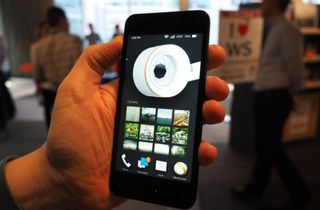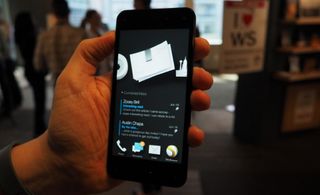5 Reasons You Don’t Want the Amazon Fire Phone
Amazon's new handset looks interesting at first glance, but it's more like a personal shopper in your pocket than a personal communicator.

Now that Amazon has its own branded smartphone, I'm expecting other retailers to launch their own handsets that not-so-subtly encourage you to buy more merch. Why not get a Walmart phone, complete with an artificially-intelligent greeter that sits on the lock screen, helping you purchase bulk-size paper towels with a single voice command?
Here are five reasons you really don't want an Amazon Fire Phone, even if you think you do.
Gimmicky Gesture Controls

Amazon has included four different cameras on its front surface so it can better capture your head movements. It has a new scroll mode that moves through the text of your books as you tilt. Although it wasn’t implemented in the same way, we've seen this feature before; it's called Smart Scroll and Samsung debuted it last year on the Galaxy S4.
The Fire phone will also show points of interest on a map when you tilt or pull up its quick settings menu when you shake it. I give you a maximum of 30 seconds before you get bored of these gimmicks.
After a lot of negative feedback about its host of annoying gesture and facial recognition features -- Smart Stay, Smart Scroll, Smart Pause, etc -- Samsung shipped its next phone with these features off by default. Why are Amazon's eye-tracking parlor tracks any better in 2014 than Samsung's were in 2013?
No Gmail, Chrome, Google Maps or YouTube
Google's Chrome browser for Android will sync your history, bookmarks and passwords with Chrome on your desktop. But if you're using the Fire Phone, you can forget about using Chrome. Amazon's Fire OS does not support Google apps such as Chrome browser, Gmail, Google Maps or YouTube. Sure, you can check your Gmail account in the Fire's mail app or visit YouTube in the Silk browser, but you're missing out on the best Google experience.
Amazon provides its own maps app that is not Google Maps. We don't know yet who powers the maps engine. There's also no Google Now assistant.
Small, Low-Res Screen

At a time when most flagship phones have full HD screens that are 5 inches or larger, the Fire Phone's 4.7-inch, 720p display feels like a relic from 2012. With Samsung and LG rolling out phones with 2560 x 1440 displays, Amazon's offering seems even longer in the tooth. The Fire does promise an eye-popping 590 nits of brightness, which should blind you just long enough for you not to notice its grainier images.
Weak Apps Compared to Competitors

Not only does Fire OS lack all of Google's own apps, but it lacks the ingenious additions offered by Samsung, HTC and LG. Samsung and LG make multitasking easier with floating windows or multi window mode. HTC offers the attractive Blinkfeed home screen to make following your social feeds easier. Motorola provides always-on voice commands. Amazon offers an app store with 25 percent of the apps available on Google Play, which all the other phones support.
Amazon's big innovations are a cute 3D image effect that's a better version of Apple's parallax wallpaper and a powerful object recognition tool that helps you buy things more effectively. Do you want a personal computer in your pocket or a personal shopper?
Lame Carousel Interface

If you feel like your index finger doesn't get enough exercise in a given day, the Fire Phone and its annoying carousel interface could be the UI you've been waiting for. Unlike standard Android, which packs a lot of information onto every home screen, lock screen and notification drawer, Fire OS encourages you to swipe from one app to another in an endless circle of repetitive stress injury pain. Yes, you can see your apps in a grid view, but regular Android home screens provide easier access to your information.
Bottom Line
Amazon's new Fire phone has a few innovative features I hope other phones adopt, including a Firefly app that can identify any object you photograph and "dynamic perspective" images and apps that change according to your eye position. Ultimately, however, the Fire's hardware and software are designed to get you to spend more money (on Prime and everything else Amazon sells) rather than to work or communicate more effectively. That’s why you should pass.
Follow Avram Piltch @Geekinchief and on Google+. Follow us @TomsGuide, on Facebook and on Google+.
Sign up to get the BEST of Tom’s Guide direct to your inbox.
Upgrade your life with a daily dose of the biggest tech news, lifestyle hacks and our curated analysis. Be the first to know about cutting-edge gadgets and the hottest deals.
